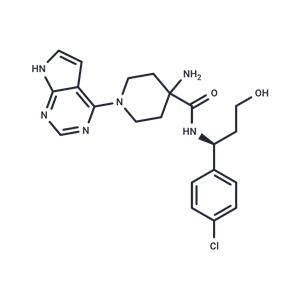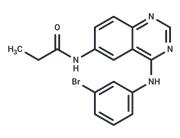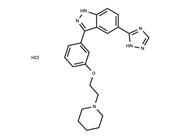| Name | Capivasertib |
| Description | Capivasertib (AZD5363) is a broad-spectrum AKT inhibitor with inhibitory activity against Akt1, Akt2, and Akt3 (IC50=3/7/7 nM) with oral activity. Capivasertib has antitumor activity for the treatment of breast cancer. |
| Cell Research | A high-throughput screening cell-based assay was developed to measure cellular AKT activity using the MDA-MB-468 breast cancer cell line. Cells were exposed to AZD5363 at concentrations ranging from 3 to 0.003 μmol/L. After a 2-hour treatment, cells were fixed with formaldehyde, washed, permeabilized with 0.5% polysorbate 20 and then probed with a phospho-specific antibody against GSK3βser9. Levels of phosphorylated GSK3βser9 were measured with an Acumen Explorer laser scanning cytometer and IC50 values estimates by fitting data in Origin 7.0. |
| Kinase Assay | The ability of AZD5363 to inhibit the activity of AKT1, AKT2 and AKT3 was evaluated by the Caliper Off-Chip Incubation Mobility Shift Assay. Active recombinant AKT1, AKT2, or AKT3 were incubated with a 5-FAM-labeled custom-synthesized peptide substrate together with increasing concentrations of inhibitor. Final reactions contained 1 to 3 nmol/L AKT1, AKT2, or AKT3 enzymes; 1.5 μmol/L peptide substrate; ATP at Km for each AKT isoform; 10 mmol/L MgCl2, 4 mmol/L dithiothreitol (DTT), 100 mmol/L HEPES, and 0.015% Brij-35. The reactions were incubated at room temperature for 1 hour and stopped by the addition of a buffer containing 100 mmol/L HEPES, 0.015% Brij-35 solution, 0.1% coating reagent, 40 mmol/L EDTA, and 5% DMSO. Plates were then analyzed using a Caliper LC3000, allowing for separation of peptide substrate and phosphorylated product by electrophoresis with subsequent detection and quantification of laser-induced fluorescence. To determine the kinase selectivity profile, AZD5363 was also tested against PKA, ROCK1, ROCK2, and P70S6K. PKA, ROCK1, and ROCK2 activity were determined by Caliper Off-Chip Incubation Mobility Shift Assay, as described earlier. Final reaction conditions for measuring ROCKI activity were 5 nmol/L active recombinant ROCK1, 1.5 μmol/L fluorescein isothiocyanate (FITC)-labeled custom peptide substrate, 7 μmol/L ATP, 1 mmol/L DTT, 5 mmol/L MgCl2, 100 mmol/L HEPES, 0.015% Brij-35, and 5 mmol/L β-glycerophosphate; final reaction for measuring ROCK2 activity contained 7.5 nmol/L active recombinant ROCK2, 1.5 μmol/L FAM-labeled custom peptide substrate, 7.5 μmol/L ATP, 1 mmol/L DTT, 10 mmol/L MgCl2, 100 mmol/L HEPES, 0.015% Brij-35, and 5 mmol/L β-glycerophosphate; and protein kinase A (PKA) activity was measured in a final reaction containing 0.0625 nmol/L PKA, 3 μmol/L FITC-labeled custom peptide substrate, 4.6 μmol/L ATP, 1 mmol/L DTT, 10 mmol/L MgCl2, 110 mmol/L HEPES, and 0.015% Brij-35.P70S6K activity was measured by a radioactive (33P-ATP) filter-binding assay. Recombinant S6K1 (T412E) was assayed against a substrate peptide (KKRNRTLTV) in a final volume of 25.5 μL containing 8 mmol/L MOPS, 200 μmol/L EDTA, 100 μmol/L substrate peptide, 10 mmol/L magnesium acetate, 20 μmol/L γ-33P-ATP (50–1,000 cpm/pmol), and increasing concentrations of AZD5363. The reactions were incubated for 30 minutes at room temperature and terminated by the addition of 0.5 mol (3%) orthophosphoric acid. Reactions were then harvested onto a P81 UniFilter and product formation quantified. IC50 values for all enzyme assays were obtained by fitting data in Origin 7.0. |
| Animal Research | When mean tumor sizes reached approximately 0.2 cm^3, the mice were randomized into control and treatment groups. The treatment groups received varying dose schedules of AZD5363 solubilized in a 10% DMSO 25% w/v Kleptose HPB buffer by oral gavage, docetaxel solubilized in 2.6% ethanol in injectable water by intravenous injection once on day 1 at 15 or 5 mg/kg once weekly. When administered in combination, docetaxel was administered 1 hour before the oral dose of AZD5363. The control group received the DMSO/Kleptose buffer alone, twice daily by oral gavage. Tumor volumes (measured by caliper), animal body weight, and tumor condition were recorded twice weekly for the duration of the study. Mice were sacrificed by CO2 euthanasia. The tumor volume was calculated (taking length to be the longest diameter across the tumor and width to be the corresponding perpendicular diameter) using the formula: (length × width) × √(length × width) × (π/6). Growth inhibition from the start of treatment was assessed by comparison of the differences in tumor volume between control and treated groups. Because the variance in mean tumor volume data increases proportionally with volume (and is therefore disproportionate between groups), data were log transformed to remove any size dependency before statistical evaluation. Statistical significance was evaluated using a one-tailed, 2-sample t-test. |
| In vitro | METHODS: Six strains of human gastric cancer cells were treated with Capivasertib (40 nM-50 µM) for 72 h. Cell viability was measured by SRB Assay.
RESULTS: The IC50 of Capivasertib on HGS27, AGS, N87, SNU-1, MKN45, and MGC803 cells were 4.6/0.1/14.18/24.04/30.0/44.4 µM, respectively. [1]
METHODS: Breast cancer cells BT474c and prostate cancer cells LNCaP were treated with Capivasertib (0.03-10 µmol/L) for 2 h, and the expression levels of target proteins were detected by Western Blot.
RESULTS: Capivasertib effectively inhibited the phosphorylation of S6 and 4E-BP1 in the cell lines, while it increased the phosphorylation of AKT at ser473 and thr308. [2] |
| In vivo | METHODS: To assay antitumor activity in vivo, Capivasertib (100-300 mg/kg, 10% DMSO 25% w/v Kleptose HPB buffer) was administered by gavage twice daily for two weeks to nude mice harboring mammary cancer tumor BT474c.
RESULTS: Capivasertib dose-dependently inhibited the growth of human tumor xenografts in vivo. [2]
METHODS: To assay antitumor activity in vivo, Capivasertib (100-300 mg/kg, 10% DMSO 25% w/v Kleptose HPB buffer) was administered by gavage to a PDGCX mouse model twice daily for twenty days.
RESULTS: Capivasertib monotherapy resulted in 60% tumor growth inhibition. [3] |
| Storage | Powder: -20°C for 3 years | In solvent: -80°C for 1 year | Shipping with blue ice. |
| Solubility Information | Ethanol : 1 mg/mL
DMSO : 50 mg/mL (116.57 mM)
10% DMSO+40% PEG300+5% Tween 80+45% Saline : 8 mg/mL (18.65 mM), Please add co-solvents sequentially, clarifying the solution as much as possible before adding the next one. Dissolve by heating and/or sonication if necessary. Working solution is recommended to be prepared and used immediately.
H2O : Insoluble
|
| Keywords | Autophagy | Inhibitor | inhibit | AZD 5363 | Capivasertib | PKB | AZD-5363 | Akt | Protein kinase B |
| Inhibitors Related | Stavudine | Xylitol | Myricetin | Sodium 4-phenylbutyrate | Hydroxychloroquine | Guanidine hydrochloride | Taurine | Curcumin | Oxyresveratrol | Paeonol | Naringin | Gefitinib |
| Related Compound Libraries | Bioactive Compound Library | Tyrosine Kinase Inhibitor Library | Kinase Inhibitor Library | Anti-Cancer Clinical Compound Library | Drug Repurposing Compound Library | Inhibitor Library | FDA-Approved Drug Library | Anti-Cancer Approved Drug Library | Anti-Cancer Drug Library | Anti-Cancer Active Compound Library |

 United States
United States



